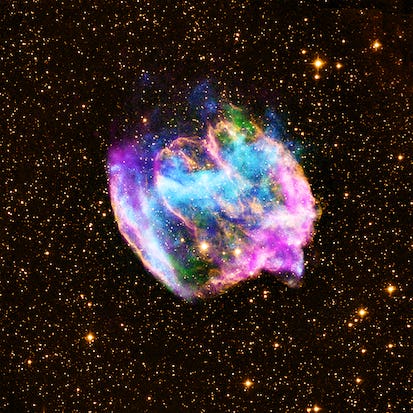- Level Foundation
- المدة 22 ساعات hours
- الطبع بواسطة Rutgers the State University of New Jersey
-
Offered by

عن
Using publicly available data from NASA of actual satellite observations of astronomical x-ray sources, we explore some of the mysteries of the cosmos, including neutron stars, black holes, quasars and supernovae. We will analyze energy spectra and time series data to understand how these incredible objects work. We utilize an imaging tool called DS9 to explore the amazing diversity of astronomical observations that have made x-ray astronomy one of the most active and exciting fields of scientific investigation in the past 50 years. Each week we will explore a different facet of x-ray astronomy. Beginning with an introduction to the nature of image formation, we then move on to examples of how our imaging program, DS9, can aid our understanding of real satellite data. You will using the actual data that scientists use when doing their work. Nothing is "canned". You will be able to appreciate the excitement that astronomers felt when they made their important discoveries concerning periodic binary x-ray sources, supernovae and their remnants, and extragalactic sources that have shaped our understanding of cosmology.الوحدات
Welcome!
1
Videos
- Course Overview
2
Readings
- Introduction
- Syllabus
Week 1 Overview
1
Readings
- Light and the Nature of Images. Plus, an introduction using DS9
Week 1 Lectures
6
Videos
- Lecture 1 The Nature of Images
- Lecture 2 Image Formation
- Lecture 3 Skipping Stones and X-ray Images
- Lecture 4 The Perception of Images
- Lecture 5 Introduction to DS9--Part I
- Lecture 6 Introduction to DS9--Part II
Week 1 Wiki
1
Readings
- Week 1 Wiki
Week 1 Quiz (homework)
1
Assignment
- Quiz 1: Week 1
Week 2 Overview
1
Readings
- DS9 and Astronomical Data
Week 2 Lectures
5
Videos
- Week 2 - Lecture 1 The DS9 Smorgasbord--Part I
- Lecture 2 The DS9 Smorgasbord--Part II
- Lecture 3 "Lies, Damned Lies, and Statistics"
- Lecture 4 Atomic Spectra, the Fingerprints of the Stars
- Lecture 5 The Cosmic Distance Scale -- Part I
Week 2 Wiki
1
Assignment
- Quiz 2: Week 2
1
Readings
- Week 2 Wiki
Week 3 Overview
1
Readings
- GK Per -- An in depth analysis
Week 3 Lectures
4
Videos
- Week 3- Lecture 1 Putting It All Together-- The HR Diagram
- Lecture 2 Of GK-Per and White Dwarfs, Part 1
- Lecture 3 Of GK-Per and White Dwarfs, Part 2
- Lecture 4 Of GK-Per and White Dwarfs, Part 3
Week 3 Wiki
1
Assignment
- Quiz 3: Week 3
1
Readings
- Week 3 Wiki
Week 4 Overview
1
Readings
- Clocks in the Sky
Week 4 Lectures
7
Videos
- Week 4 - Lecture 1 Orbits
- Lecture 2 A Matter of Some Gravity
- Lecture 3 Of Hummingbirds, Trains and The Doppler Shift
- Lecture 4 Clocks in the Sky-- Cen X-3, Part 1--Exosat
- Lecture 5 Clocks in the Sky-- Cen X-3, Part 2
- Lecture 6 Clocks in the Sky-- Cen X-3, Part 3
- Lecture 7 Clocks in the Sky--Cen X-3, Part 4--Chandra
Week 4 Wiki
1
Assignment
- Quiz 4: Week 4
1
Readings
- Week 4 Wiki
Week 5 Overview
1
Readings
- Cosmic Recycling Centers
Week 5 Lectures
2
Videos
- Week 5 - Lecture 1 Cosmic Recycling Centers and Cas-A, Part 1
- Lecture 2 Cosmic Recycling Centers and Cas-A, Part 2: "Color it X-ray"
Week 5 Wiki
1
Assignment
- Quiz 5: Week 5
1
Readings
- Week 5 Wiki
Week 6 Overview
1
Readings
- Coming into the home stretch
Week 6 Lectures
5
Videos
- Week 6 - Lecture 1 The Time Machine, Part 1
- Lecture 2 The Time Machine, Part 2
- Lecture 3 The Time Machine, Part 3
- Lecture 4 The Time Machine, Part 4
- Lecture 5 To the Ends of the Universe: The Cosmic Distance Scale -- Part II
Week 6 Wiki
1
Assignment
- Quiz 6: Week 6
1
Readings
- Week 6 Wiki
Wrapping it all up
1
Readings
- Wrapping it all up
Auto Summary
"Analyzing the Universe" is a foundational course in Personal Development offered by Coursera. Guided by expert instructors, learners delve into x-ray astronomy using real NASA satellite data, exploring neutron stars, black holes, quasars, and supernovae. The course spans 1320 minutes and utilizes the DS9 imaging tool for hands-on analysis. Subscription options include Starter, Professional, and Paid plans, making it accessible to astronomy enthusiasts and budding scientists alike.

Dr. Terry A. Matilsky

